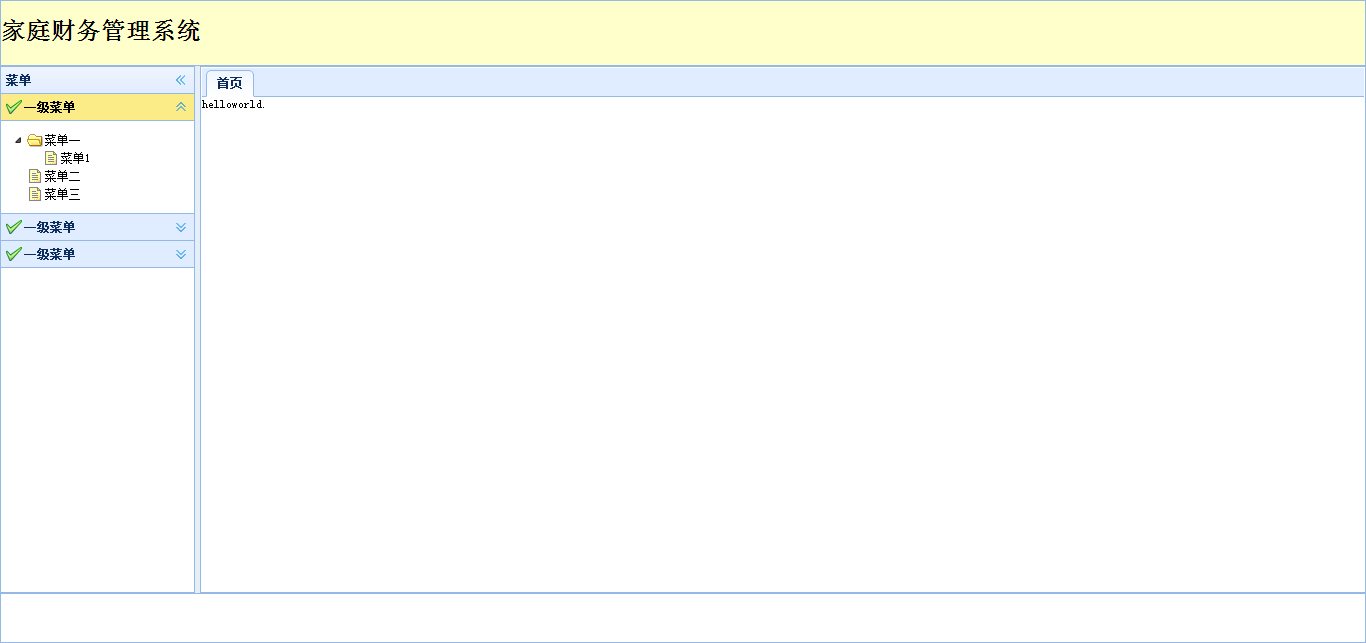先贴个效果图:
用easyui-layout布局主框架,index.jsp内容如下:
<%@ page language="java" contentType="text/html; charset=utf-8"
pageEncoding="UTF-8"%>
<!DOCTYPE html PUBLIC "-//W3C//DTD HTML 4.01 Transitional//EN" "http://www.w3.org/TR/html4/loose.dtd">
<%
String path = request.getContextPath();
String basePath = request.getScheme() + "://"
+ request.getServerName() + ":" + request.getServerPort()
+ path ;
%>
<html>
<head>
<meta http-equiv="Content-Type" content="text/html; charset=utf-8">
<title>家庭财务管理系统</title>
<link rel="stylesheet" type="text/css"
href="<%=basePath%>/res/css/easyui/default/easyui.css">
<link rel="stylesheet" type="text/css" href="<%=basePath%>/res/css/easyui/icon.css">
<script type="text/javascript" src="<%=basePath%>/res/js/jquery.min.js"></script>
<script type="text/javascript" src="<%=basePath%>/res/js/jquery.easyui.min.js"></script>
<script type="text/javascript" src="<%=basePath%>/res/js/easyui-lang-zh_CN.js"></script>
<script>
$(function(){
$('#tabs').tabs('add',{
title:'首页',
href:'main.jsp',
closable:false
});
$('.easyui-tree').tree({
onClick:function(node){
}
});
});
</script>
</head>
<body class="easyui-layout">
<div data-options="region:'north',noheader:true,split:false" style="height:66px;background:#FFFFCC">
<h1>家庭财务管理系统</h1>
</div>
<div data-options="region:'south',noheader:true,split:false" style="height:50px;"></div>
<div data-options="region:'west',title:'菜单',split:true" style="width:200px;">
<div class="easyui-accordion" border="false" id='menu'>
${menus}
</div>
</div>
<div data-options="region:'center'," style="padding:1px;">
<div id='tabs' class="easyui-tabs" data-options="fit:true,border:false">
</div>
</div>
</body>
</html>布局是经典式布局,北南西中,北以后可以换成一个logo图片,西边放操作菜单,南边是copyright等,主内容区对应菜单点击后的各个页面,以tab来实现。
下面来看左菜单的实现。
package system.homebank.controller;
import java.util.List;
import javax.annotation.Resource;
import org.springframework.stereotype.Controller;
import org.springframework.ui.Model;
import org.springframework.web.bind.annotation.RequestMapping;
import system.homebank.entity.Menu;
import system.homebank.service.MenuService;
import system.homebank.utils.MenuUtils;
@Controller
public class HomePageController
{
@Resource
private MenuService service;
@RequestMapping("/home.do")
public String forward(Model model)
{
List<Menu> list = this.service.getAllMenu();
String menus = MenuUtils.buildMenus(list);
model.addAttribute("menus", menus);
return "/index";
}
}
上面forward控制主页转向的,里面的代码主要是准备主页数据,暂时只准备左侧菜单数据,以后会有其他数据。
MenuService接口中主要提供菜单数据的读取。
MenuUtils.buildMenus(list)将菜单数据解析成html串。
package system.homebank.utils;
import java.util.ArrayList;
import java.util.HashMap;
import java.util.List;
import java.util.Map;
import system.homebank.entity.Menu;
import system.homebank.model.TreeNode;
public class MenuUtils
{
public static String buildMenus(List<Menu> menuList)
{
if (menuList == null)
{
return null;
}
List<TreeNode> nodeList = new ArrayList<TreeNode>();
for (Menu m : menuList)
{
TreeNode treeNode = new TreeNode(m.getId(), m.getMenuname(),m.getUrl(), m.getParentid());
nodeList.add(treeNode);
}
Map<String,TreeNode> map = new HashMap<String,TreeNode>();
for (TreeNode node : nodeList)
{
map.put(node.getId(), node);
}
List<TreeNode> ret = new ArrayList<TreeNode>();
for (TreeNode node : nodeList)
{
String id = node.getId();
String parentid = node.getParentid();
if (parentid.compareTo(id) == 0 )
{
ret.add(node);
}
else
{
TreeNode parentNode = (TreeNode)map.get(parentid);
if (parentNode == null)
{
throw new RuntimeException(String.format("节点%s的父节点%s没找到", node.getId(),parentid));
}
parentNode.addChild(node);
}
}
return createHtml(ret);
}
private static String createHtml(List<TreeNode> list)
{
String result = "";
String menu = "<div title=\"%s\" iconCls=\"icon-ok\" style=\"padding:10px;\"><ul class=\"easyui-tree\" data-options='data:%s'></ul></div>";
for (TreeNode o : list)
{
result = result + String.format(menu, new Object[] { o.getText(), JSONBinder.buildNormalBinder().toJson(o.getChildren()) });
}
return result;
}
}
上面用到了TreeNode结构,TreeNode.java内容如下:
package system.homebank.model;
import java.io.Serializable;
import java.util.ArrayList;
import java.util.List;
public class TreeNode implements Serializable
{
private static final long serialVersionUID = 2235783844919124916L;
private String id;
private String text;
private Attributes attributes;
private String parentid;
private List<TreeNode> children;
public TreeNode()
{
}
public TreeNode(Integer id, String text,String url, Integer parentid)
{
this.id = id.toString();
this.text = text;
this.attributes = new Attributes();
this.attributes.setUrl(url);
this.parentid = parentid.toString();
}
public void addChild(TreeNode child)
{
if (this.children == null)
{
this.children = new ArrayList<TreeNode>();
}
this.children.add(child);
}
public String getId()
{
return id;
}
public void setId(String id)
{
this.id = id;
}
public String getText()
{
return text;
}
public void setText(String text)
{
this.text = text;
}
public Attributes getAttributes()
{
return attributes;
}
public void setAttributes(Attributes attributes)
{
this.attributes = attributes;
}
public String getParentid()
{
return parentid;
}
public void setParentid(String parentid)
{
this.parentid = parentid;
}
public List<TreeNode> getChildren()
{
return children;
}
public void setChildren(List<TreeNode> children)
{
this.children = children;
}
}
TreeNode表示一个树的节点,节点的附加信息放到Attribultes中, Attribultes中我暂时只放了url信息,当点击菜单时,根据url去向后台发送相应的请求。
以上为实现左菜单的主要代码。
菜单表的设计如下:
CREATE TABLE `menu` (
`id` decimal(4,0) NOT NULL,
`menuname` varchar(50) NOT NULL,
`url` varchar(100) DEFAULT NULL,
`parentid` decimal(4,0) DEFAULT NULL,
PRIMARY KEY (`id`)
)以上为本次全部内容,系统功能全部实现后,再放上源码上来。
